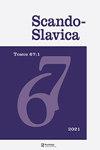The Spread of Potential Mood Marking in Conditionals in Standard Macedonian
IF 0.2
0 HUMANITIES, MULTIDISCIPLINARY
引用次数: 0
Abstract
ABSTRACT This paper discusses the consequences of the reintroduction of the potential mood marker bi-construction into the system of conditional marking in standard Macedonian. This marker had been almost lost from the Balkanized conditional patterns in Macedonian dialects which were based on the opposition hypothetical vs. counterfactual. The counterfactual was realized by the isomorphic Balkan conditional type: subjunctive mood in the protasis and a construction based on the future marker ḱe + imperfect verb in the apodosis. Under the influence of the neighboring Slavic languages the bi-construction reentered the conditional system penetrating into existing patterns and creating new ones. The spread of the bi-patterns is confirmed by the results of the quantitative analysis of the examples from literary works belonging to different periods. It is highly possible that this “comeback” was enabled by the imported conditional patterns with koga ‘when’ and dokolku ‘in case/if’ realized in potential mood. The main hypothesis is that the borrowed conditional patterns enriched the system of conditional marking in Macedonian causing its partial realignment. Although semantically overlapping with the Balkan conditional pattern, these two patterns typically code present and future unrealizable situations, often endowed with special discourse functions.标准马其顿语条件句中潜在语气标记的传播
摘要本文讨论了在标准马其顿语条件标记系统中重新引入潜在语气标记双构式的后果。这个标记在马其顿方言的巴尔干化条件句型中几乎消失了,这些句型是基于假设与反事实的对立。反事实是通过同构的巴尔干条件类型来实现的:主句中的虚拟语气和主句中基于将来标记ḱe +不完成动词的结构。在邻近斯拉夫语的影响下,双构语重新进入条件体系,渗透到已有的格局中,创造新的格局。通过对不同时期的文学作品样本的定量分析,证实了双模式的传播。这种“回归”很有可能是通过导入的条件模式实现的,在潜在情绪中实现了koga ' when '和dokolku ' in case/if '。主要的假设是,借用的条件模式丰富了马其顿语条件标记系统,导致其部分重新调整。虽然这两种模式在语义上与巴尔干条件模式重叠,但它们通常编码现在和将来不可实现的情况,通常被赋予特殊的话语功能。
本文章由计算机程序翻译,如有差异,请以英文原文为准。
求助全文
约1分钟内获得全文
求助全文

 求助内容:
求助内容: 应助结果提醒方式:
应助结果提醒方式:


